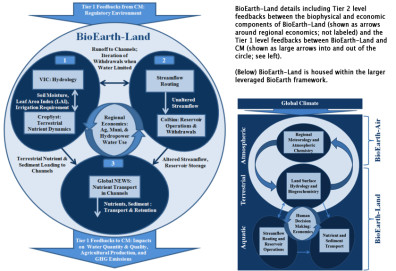Current Research
Past Research
-
- Understanding surface water nitrogen and phosphorus loading and removal for the US
- Nutrient transformation and retention by lakes and reservoirs
- Understanding the biogeochemistry and hydrology of “green” infrastructure
- Modeling nutrient and organic carbon loads and sources in California’s Central Valley Watersheds
- Agriculture and pollution in the developing world: understanding the link between fertilizer use, greenhouse gases, and coastal change in Sonora, Mexico
Understanding and Characterizing Greenhouse Gas Emissions From Water Reservoirs and Possible Mitigation Techniques via Control of Water Level Drawdown Regime
Human demand for critical services like energy supply, clean drinking water, irrigation, and flood control have led to the 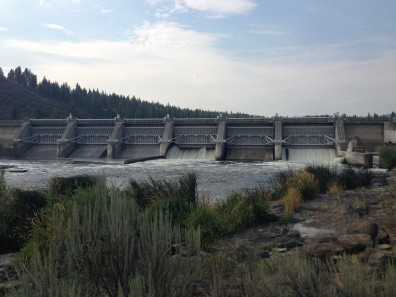 construction and operation of over a million dams globally. Reservoirs are extremely biogeochemically active systems, contributing to both the removal of excess nutrients and to the production of potent greenhouse gases (GHGs), such as methane. Because reservoirs are managed ecosystems, a better understanding of how their hydrology affects these processes may lead to powerful management opportunities for both water quality and climate change mitigation. This work investigates the affect of various reservoir water level drawdown regimes on water quality and GHG production in a series of Pacific Northwest reservoirs. These reservoirs have differing drawdown regimes based on their primary use: hydroelectric, flood control, recreation, or irrigation. Preliminary findings from one reservoir (Lacamas Lake, WA) suggest that water level drawdowns, and the associated drop in hydrostatic pressure, result in large releases of methane bubbles from the sediments.
construction and operation of over a million dams globally. Reservoirs are extremely biogeochemically active systems, contributing to both the removal of excess nutrients and to the production of potent greenhouse gases (GHGs), such as methane. Because reservoirs are managed ecosystems, a better understanding of how their hydrology affects these processes may lead to powerful management opportunities for both water quality and climate change mitigation. This work investigates the affect of various reservoir water level drawdown regimes on water quality and GHG production in a series of Pacific Northwest reservoirs. These reservoirs have differing drawdown regimes based on their primary use: hydroelectric, flood control, recreation, or irrigation. Preliminary findings from one reservoir (Lacamas Lake, WA) suggest that water level drawdowns, and the associated drop in hydrostatic pressure, result in large releases of methane bubbles from the sediments.
Related Publications
- Harrison, J.A., Y.T. Prairie, S. Mercier-Blais, and C. Soued, (2021) Year-2020 Global Distribution and Pathways of Reservoir Methane and Carbon Dioxide Emissions According to the Greenhouse Gas from Reservoirs (G-res) Model, Global Biogeochemical Cycles. https://doi.org/10.1029/2020GB006888
- Prairie, Y.T., S. Mercier-Blais, J.A. Harrison, C. Soued, P. del Giorgio, A. Harby, J. Alm, V. Chanudet, and R. Nahas (2021). A new modeling framework to assess biogenic GHG emissions from reservoirs: The G-res Tool, Environmental Modeling and Software. https://doi.org/10.1016/j.envsoft.2021.105117
- Peacock, M., J. Audet, D. Bastviken, M.N. Futter, V. Gauci, A. Grinham, J.A. Harrison, M.S. Kent, S. Kosten, C.E. Lovelock, A. J. Veraart, and C.D. Evans (2021) Global importance of methane emissions from drainage ditches and canals, Environmental Research Letters. 16 044010. https://doi.org/10.1088/1748-9326/abeb36
- D’Ambrosio, S., and J.A. Harrison (2021) Methanogenesis exceeds CH4 consumption in eutrophic lake sediments. Limnology and Oceanography Letters. https://doi.org/10.1002/lol2.10192
- van Grinsven, S., J.S.S. Damsté, J.A. Harrison, L. Polerecky, and L. Villanueva (2021) Nitrate enables the transfer of methane-derived carbon from the methanotroph Methylobactersp.to the methylotroph Methylotenera sp. in eutrophic lake water, Limnology and Oceanography. https://doi.org/10.1002/lno.11648
- van Grinsven, S., J.S.S. Damsté, J.A. Harrison, and L. Villanueva (2020) Impact of electron acceptor availability on methane-influenced microorganisms in an enrichment culture obtained from a stratified lake, Frontiers in Microbiology. https://doi.org/10.3389/fmicb.2020.00715
- van Grinsven, S., D. Jaap, A.A. Asbun, J. Engelmann, J.A. Harrison, and L. Villanueva (2020) Methane oxidation by Methylobacter in an anoxic lake stimulated by nitrate and sulfate, Environmental Microbiology, https://doi.org/10.1111/1462-2920.14886.
- Lovelock, C.E., C. Evans, N. Barros, Y.T. Prairie, J. Alm, D. Bastviken, J. J. Beaulieu, M. Garneau, A. Harby, J.A. Harrison, D. Pare, H. Lerche Raadal, B. Sherman, C. Zhang, S.M. Ogle, A. Grinham, B.R. Deemer, M. dos Santos, S. Kosten, M. Peacock, Z. Li, V. Stepanenko (2019), Chapter 7: Wetlands, in the 2019 Refinement to the 2006 IPCC Guidelines for National Greenhouse Gas Inventories
- Prairie, Y.T., J. Alm, J.J. Beaulieu, N. Barros, T. Battin, J. Cole, P. del Giorgio, T. DelSontro, F. Guérin, A. Harby, J.A. Harrison, S. Mercier-Blais, D. Serça, S. Sobek, and D. Vachon, (2018) Greenhouse gas emissions from freshwater reservoirs: what does the atmosphere see? Ecosystems. DOI: 10.1007/s10021-017-0198-9.
- Beaulieu J.J., D.A. Balz, M.K. Birchfield, J.A. Harrison, C.T. Nietch, M.C. Platz, W.C. Squier, S. Waldo, J.T. Walker, K.M. White, and J.L. Young (2018) Effects of an experimental water-level drawdown on methane emissions from a eutrophic reservoir, Ecosystems. DOI: 10.1007/s10021-017-0176-2.
- Harrison, J.A., B.R. Deemer, M.K. Birchfield, and M. O’Malley (2017) Reservoir water-level drawdowns accelerate and amplify methane emission, Environmental Science and Technology. doi: 10.1021/acs.est.6b03185.
- Reed, D.C., *B.R. Deemer, S. van Grinsven, and J.A. Harrison (2017) Do elusive electron acceptors mediate anaerobic methane oxidation in lakes and reservoirs?, Biogeochemistry, 10.1007/s10533-017-0356-3.
- Deemer, B.R., J.A. Harrison, S. Li, J.J. Beaulieu, T. DelSontro, N. Barros, J. F. B. Neto, S.M. Powers, M.A. dosSantos, and J.A. Vonk, (Submitted) Greenhouse gas emissions from reservoirs: a new global synthesis, Bioscience, https://doi.org/10.1093/biosci/biw117.
Integrating Physics and Biogeochemistry to Understand Controls on Biogeochemical Transformations in Reservoirs
Among aquatic ecosystems, reservoirs contribute
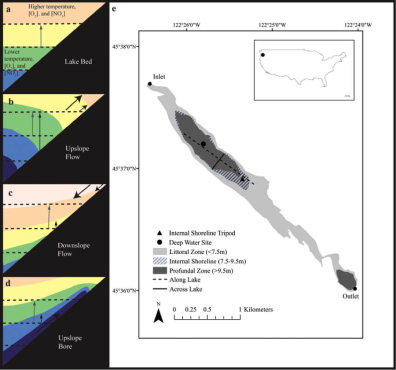
disproportionately to the retention of biologically available nitrogen (N) as it travels downstream through watersheds. N can be retained within reservoirs via a number of mechanisms (e.g. sediment burial, biotic uptake), but microbially mediated denitrification is the only permanent form of removal. As of yet, however, methodological limitations have hindered our understanding of the seasonal and spatial patterns of reservoir denitrification, as well as the importance of denitrification relative to less permanent N retention pathways.
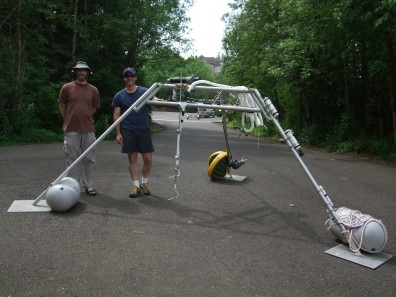
Through intensive sampling of a local eutrophic reservoir (Lacamas Lake, WA), this project aims to develop a powerful measurement technique that combines approaches from fluid dynamics and biogeochemistry to quantify in situ denitrification rates and other biogeochemical transformations and fluxes. Through multidisciplinary collaboration with the WSU geophysics lab, the project also aims to characterize the role of internal waves and physical mixing in determining hot spots and hot moments for denitrification within the reservoir.
Related Publications
- Deemer, B.R. and J.A. Harrison (2019) Summer redox dynamics in a eutrophic reservoir and sensitivity to a summer’s-end drawdown event, Ecosystems. https://doi.org/10.1007/s10021-019-00362-0.
- Perkins, K.R., G. Rollwagen-Bollens, S.M. Bollens, and J.A. Harrison (2019) Variability in the vertical distribution of chlorophyll in a spill-managed temperate reservoir, Lake and Reservoir Management. 35(2): 119–126. https://doi.org/10.1080/10402381.2019.1566935.
- Deemer, B.R., S.M. Henderson, and J.A. Harrison, (2015) Chemical mixing in the bottom boundary layer of a eutrophic reservoir: the effects of internal seiching on nitrogen dynamics, Limnology and Oceanography, 1-24, doi: 10.1002/lno.10125.
top
Pacific Northwest Watershed Biogeochemistry
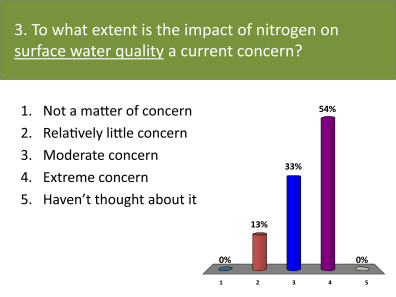
A number of issues are emerging regarding nutrient loading and transport in Pacific Northwest watersheds, including non-point inputs of N and P from natural, agricultural, and urban sources and influence of reservoir management on nutrient dynamics in large rivers. In recent years our group has participated in two efforts to develop regional understanding of Earth system dynamics called BioEarth and Watershed Integrated Systems Dynamics Modeling (WISDM). Our primary role in these projects has been to develop the capacity to examine the impact of climate and land-use change on nutrient transport and water quality. In the months and years to come, we will continue to develop a focus on understanding relationships between land use and nutrient transport in the streams and rivers of this region.
Related Publications
- Grieger, S., and J.A. Harrison (2021) Long-term Disconnect between Nutrient Inputs and Riverine Exports in a Semi-arid, Agricultural Watershed: Yakima River Basin 1945-2012, JGR-Biogeosciences. https://doi.org/10.1029/2020JG006072
- Bollens, S.M., J.A. Harrison, M.G. Kramer, G. Rollwagen-Bollens, T.D. Counihan, S.B. Robb-Chavez, and S.T. Nolan (2021) Calcium concentration in the lower Columbia River, USA, and its implications for invasive bivalves, River Research and Applications, 1–6. https://doi.org/10.1002/rra.3804
- Metson, G.S., J. Lin, J.A. Harrison, J.E. Compton (2020) Four decades of watershed nitrogen and phosphorus balances in the Willamette River Basin, Oregon, USA, JGR-Biogeosciences. https://doi.org/10.1029/2020JG005792
- Steenstra, P., N. Strigul, and J.A. Harrison (2020) Tungsten in Washington State Surface Waters. Chemosphere. 242:1-11. https://doi.org/10.1016/j.chemosphere.2019.125151.
- Adam, J.C., Stephens, S.H. Chung, M.P. Brady, R.D. Evans, C.E. Kruger, B.K. Lamb, M.L. Liu, C.O. Stöckle, J.K. Vaughan, K. Rajagopalan, J.A. Harrison, C.L. Tague, A. Kalyanaraman, Y. Chen, A. Guenther, F.Y. Leung, L.R. Leung, A.B. Perleberg, J. Yoder, E. Allen, S. Anderson, B., Chandrasekharan, K. Malek, T. Mullis, *C. Miller, T. Nergui, J. Poinsatte, J. Reyes, J. Zhu, J.S. Choate, X. Jiang, R. Nelson, J.H. Yoon, G.G. Yorgey, K.J. Chinnayakanahalli, A.F. Hamlet, B. Nijssen. (2014) BioEarth: A Regional Biosphere-Relevant Earth System Model to Inform Agricultural and Natural Resource Management Decisions. Climatic Change, DOI:10.1007/s10584-014-1115-2.
- Liu, M., K. Rajagopalan, S. H. Chung, X. Jiang, J. Harrison, T. Nergui, A. Guenther, C. Miller, J. Reyes, C. Tague, J. Choate, E.P. Salathé, C.O. Stöckle, and J. C. Adam, (2014) What it is the importance of climate model bias when projecting the impacts of climate change on land surface processes? Biogeosciences, doi:10.5194/bg-11-2601-2014.
- Deemer, B., K.E. *Goodwin, K. Birchfield, *K. Dallavis, *J. Emerson, *D. Freeman, *E. Henry, *T. Lee, *L. Wynn, and J.A. Harrison (2012) Elevated nitrogen and phosphorus concentrations in urbanizing southwest Washington streams. Northwest Science. 86(4):237-247.
Global Nutrient Transport and Effects
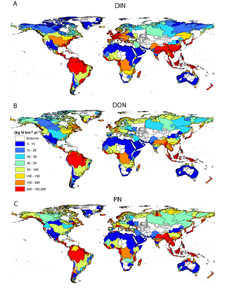
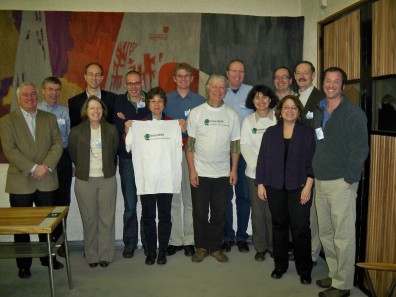
Over the past century, humans have greatly altered Earth’s nitrogen, phosphorus, carbon, and silica cycles, often accelerating the transport of these essential nutrients downstream through watersheds. Once delivered to lakes, streams, rivers, and the coastal zone, these nutrients can degrade ecosystems and affect human well-being by stimulating algal growth, causing shifts in primary producer communities (e.g. loss of seagrass habitats), increasing the extent and duration of anoxic and hypoxic waters, stimulating harmful algal blooms, and harming coral reefs. In addition, nutrient enrichment also contributes to increasing anthropogenic emissions of nitrous oxide, a trace gas in the atmosphere that contributes to global warming and to the destruction of stratospheric ozone.
To better understand and predict patterns, causes, and consequences, of aquatic nutrient loading our group has, with UNESCO-IOC support, collaborated with scientists around the world to develop and apply a system of nutrient spatially explicit nutrient loading and transport models called Global Nutrient Export from Watersheds (Global NEWS). We use these and other models to answer both basic scientific and management-driven questions. More recently, we have directly linked coastal nutrient loading to coastal oxygen conditions for the first time at the global scale with a model called the Coastal Ocean Oxygen Linked to Benthic Exchange And Nutrient Supply (COOLBEANS) model.
Related Publications
- Metson, G.S., G. MacDonald, A. Leach, J. Compton, J.A. Harrison, and J.N. (2020) Consumer-oriented phosphorus and nitrogen footprints for U.S. diets, Environmental Research Letters. https://doi.org/10.1088/1748-9326/aba781
- Harrison, J.A., A.H.W Beusen, G. Fink, T. Tang, M. Strokal, A.F. Bouwman, G.S. Metson, and L. Vilmin (2019) Modeling phosphorus in rivers at the global scale: recent successes, remaining challenges, and near-term opportunities, Current Opinion in Environmental Sustainability. 36: 68-77. https://doi.org/10.1016/j.cosust.2018.10.010
- van Vliet, M.T.H., M. Flörke, J.A. Harrison, N. Hofstra, V. Keller, F. Ludwig, J.E. Spanier, M. Strokal, Y. Wada, Y. Wen, and R. Williams (2019) Model inter-comparison design for large-scale water quality models, Current Opinion in Environmental Sustainability. 36: 59-67. https://doi.org/10.1016/j.cosust.2018.10.013.
- Janssen, A.B.G., J.H. Janse, A.H.W. Beusen, M. Chang, J.A. Harrison, I. Huttunen, X. Kong, J. Rost, S. Teurlincx, T.A. Troost, D. van Wijk, and W.M. Mooij (2019) How to model algal blooms in any lake on earth, Current Opinion in Environmental Sustainability. https://doi.org/10.1016/j.cosust.2018.09.001.
- Glibert, P.M., A.H.W. Beusen, J.A. Harrison, H. Dürr, A.F. Bouwman, and G. Laruelle (2018) Changing land-, sea-, and airscapes: sources of nutrient pollution affecting habitat suitability for harmful algae, Chapter 4 in: GEOHAB Synthesis Book; The Ecology and Oceanography of Harmful Algal Blooms, P.M. Glibert Ed., Springer Nature.
- Reed, D.C., and J.A. Harrison (2016) Linking nutrient loading and oxygen in the global coastal ocean: a modelling analysis, Global Biogeochemical Cycles. 30, doi:10.1002/2015GB005303.
- McCrackin, M., J.A. Harrison, and J.E. Compton, (2014) Factors influencing seasonal export of dissolved inorganic nitrogen by major rivers, Global Biogeochemical Cycles, DOI: 10.1002/2013GB004723.
- Mayorga, E., S.P. Seitzinger, J.A. Harrison, E. Dumont, and A.H.W. Beusen (2010) Riverine sources, retention and export of nutrients and carbon: An enhanced framework and integrated scenarios application of the Global Nutrient Export from WaterSheds (NEWS) model, Environmental Modelling & Software, 25(7) 837–853.
(pdf) - Seitzinger, S.P., E. Mayorga, C. Kroeze, A.F. Bouwman, A.H.W. Beusen,G. Billen, G. Van Drecht, E. Dumont, B.M. Fekete, J. Garnier, and J.A. Harrison (2010) Global river nutrient export: a scenario analysis of past and future trends. Global Biogeochemical Cycles, 24, GB0A08, doi:10.1029/2009GB003587.
(pdf) - Harrison, J. A., A. F. Bouwman, E. Mayorga, and S. Seitzinger (2010), Magnitudes and sources of dissolved inorganic phosphorus inputs to surface fresh waters and the coastal zone: A new global model, Global Biogeochem. Cycles, 24, GB1003, doi:10.1029/2009GB003590.
(pdf) - Seitzinger, S. P. and J. A. Harrison, (2008) Sources and Delivery of Nitrogen to Coastal Systems, Chapter 8 in Nitrogen in the Marine Environment, 2nd edition. D. Capone, D.A. Bronk, M. R. Mullholland, E. Carpenter Eds., Academic Press, New York.
(pdf) - Wolheim, W.M., C.J. Vorosmarty, A.F. Bouwman, P. Green, J.A. Harrison, M. Meybeck, B.J. Peterson, S.P. Seitzinger, and J.P. Syvitski (2008) A spatially distributed framework for aquatic modeling of the Earth system (FrAMES). Global Biogeochemical Cycles, DOI:10.1029/2007GB002963
(pdf) - Seitzinger, S.P., J. A. Harrison, E. Dumont, A. H. W. Beusen, and A.F. Bouwman. (2005) Sources and delivery of carbon, nitrogen, and phosphorus to the coastal zone: an overview of Global NEWS models, Global Biogeochemical Cycles, 19, doi:10.1029/2005GB002606, 1-11.
(pdf) - Dumont, E., J.A. Harrison, C. Kroeze, E.J. Bakker and S.P. Seitzinger (2005) Global distribution and sources of DIN export to the coastal zone: results from a spatially explicit, global model (NEWS-DIN), Global Biogeochemical Cycles, 19, doi:10.1029/2005GB002488, 1-14.
(pdf) - Beusen, A.H.W., A.L.M. Dekkers, A.F. Bouwman, W. Ludwig and J.A. Harrison (2005) Estimation of global river transport of sediments and associated particulate carbon, nitrogen, and phosphorus, Global Biogeochemical Cycles, 19, doi:10.1029/2005GB002453, 1-19.
(pdf)
Modeling Surface Water Nitrogen and Phosphorus Loading and Removal for the US
In the US, humans have increased terrestrial N-fixation rates more than 3.5-fold on-average over
background rates. While there have been efforts to mitigate losses of N to the environment through the Clean Air Act and Clean Water Act, 20% of US lakes have high levels of N that negatively affect ecosystem health and 70% of US estuaries have been degraded by nutrient loading. In many agricultural communities, nitrate concentrations in surface and groundwater remain elevated and even exceed the US federal drinking water standard (10 mg/L). The number of violations of the nitrate standard nearly doubled between 1998 and 2008 and will likely continue to increase in the future as nitrogen applied to agricultural fields continues to leach into groundwater. Phosphorus loading to surface waters has also
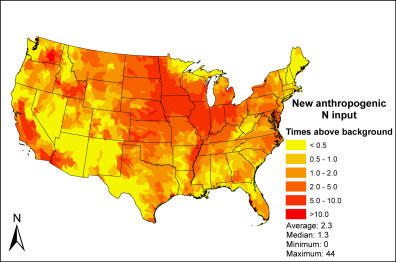
increased over a similar time period, with similarly harmful effects.
In collaboration with the Western Ecology Division of the US EPA, we are using existing data and models output to quantify the fluxes and sources of N and phosphorus to the US coastal zone. Some of the research questions we are addressing are: 1) What are the sources of nitrogen and phosphorus delivered by rivers to coastal areas of the US? 2) How will population growth influence nitrogen and phosphorus loading to the US coastal zone? 3) What is the potential to reduce coastal nitrogen and phosphorus loads through improved nutrient management?
Related Publications
- Metson, G. S., J. Lin, J.A. Harrison, and J.E. Compton (2017) Linking 2012 terrestrial P inputs to riverine export from watersheds across the United States, Water Research, 10.1016/j.watres.2017.07.037.
- McCrackin, M.L., E.J. Cooter, R.L. Dennis, J.A. Harrison, and J.E. Compton (2017) Monthly dissolved inorganic nitrogen export from the Mississippi River Basin: a new, loosely coupled multimedia model, Biogeochemistry. doi:10.1007/s10533-017-0331-z.
- McCrackin, M., J.A. Harrison, and J.E. Compton, (2014) Future riverine nitrogen export to US coastal regions: prospects for improving water quality amid future population growth, Journal of Environmental Quality, DOI:10.2134/jeq2014.02.0081.
- Sobota D.J., J.E. Compton, and J.A. Harrison (2013) Reactive nitrogen in the United States: How certain are we about sources and fluxes? Frontiers in Ecology and the Environment. doi:10.1890/110216.
- McCrackin, M., J.A. Harrison, and J.E. Compton, (2013) A comparison of NEWS and SPARROW models to understand sources of nitrogen delivered to US coastal Areas, Biogeochemistry, doi:10.1007/s10533-012-9809-x.
- Baron, J.S., E.K. Hall, B.T. Nolan, J.C. Finlay, E. Bernhardt, J.A. Harrison, F. Chan, and E.W. Boyer, (2012) The interactive effects of human-derived nitrogen loading and climate change on aquatic ecosystems of the United States, Biogeochemistry. DOI 10.1007/s10533-012-9788-y.
- Compton, J.E., J.A. Harrison, R.L. Dennis, T.L. Greaver, B.H. Hill, S.J. Jordan, H. Walker, and H.V. Campbell (2011) Ecosystem services altered by human changes in the nitrogen cycle: A new perspective for US decision making. Ecology Letters.
(pdf)
Nutrient Transformation and Retention by Lakes and Reservoirs
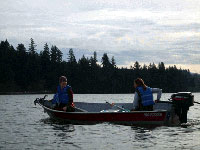 Lakes and reservoirs play a key role in trapping and removing reactive N, P and Si as these compounds move downstream through watersheds. Our lab studies nutrient cycling and removal in lakes and reservoirs at various scales. Approaches range from the intensive biogeochemical investigation of a local eutrophic reservoir (Lacamas Lake) to regional and global modeling efforts focused on quantifying N, P, and Si removal by lake and reservoir systems. We are particularly interested in improving understanding of seasonal variation in nutrient dynamics, with the hope that this information may be used to reduce nutrient pollution.
Lakes and reservoirs play a key role in trapping and removing reactive N, P and Si as these compounds move downstream through watersheds. Our lab studies nutrient cycling and removal in lakes and reservoirs at various scales. Approaches range from the intensive biogeochemical investigation of a local eutrophic reservoir (Lacamas Lake) to regional and global modeling efforts focused on quantifying N, P, and Si removal by lake and reservoir systems. We are particularly interested in improving understanding of seasonal variation in nutrient dynamics, with the hope that this information may be used to reduce nutrient pollution.
Related Publications
- Harrison, J.A., P. Frings, A.H.W. Beusen, D.J. Conley, and M.L. McCrackin (2012) Global importance, patterns, and controls of dissolved silica retention in lakes and reservoirs, Global Biogeochemical Cycles, doi:10.1029/2011GB004228.
- Deemer, B.R., J.A. Harrison, and E.W. Whitling (2011) Microbial nitrogen removal and nitrous oxide production in a small eutrophic reservoir: an in situ approach to quantifying hypolimnetic process rates. Limnology and Oceanography, 56(4) 1189-1199, doi:10.4319/lo.2011.56.4.1189.
(pdf) - Harrison, J.A., R. Maranger, R.B. Alexander, A. Giblin, P.-A. Jacinthe, E. Mayorga, S.P. Seitzinger, D.J. Sobota, and W. Wollheim (2009) Controls and significance of N retention in lakes and reservoirs. Biogeochemistry, DOI 10.1007/s10533-008-9272-x.
(pdf) - Seitzinger, S.P., J.A. Harrison, J.K. Bohlke, A.F. Bouwman, R. Lowrance, B.J. Peterson, C. Tobias, and G. Van Drecht (2006) Denitrification across landscapes and waterscapes: a synthesis, Ecological Applications, 16, (6), 2064–2090.
(pdf) - Harrison, J.A., N.F. Caraco and S.P. Seitzinger (2005) Global distribution and sources of dissolved organic matter export by rivers: results from a spatially explicit, global model (NEWS-DOM), Global Biogeochemical Cycles, 19 (4), doi:10.1029/2005GB002480, 1-16.
(pdf) - Harrison, J.A., S.P. Seitzinger, A.F. Bouwman, N.F. Caraco, A.H.W. Beusen and C. Vörösmarty (2005) Dissolved inorganic phosphorus export to the coastal zone: results from a spatially explicit, global model (NEWS-DIP), Global Biogeochemical Cycles, 19, doi:10.1029/2004GB002357, 1-15.
(pdf)
Understanding the Biogeochemistry and Hydrology of “Green” Infrastructure
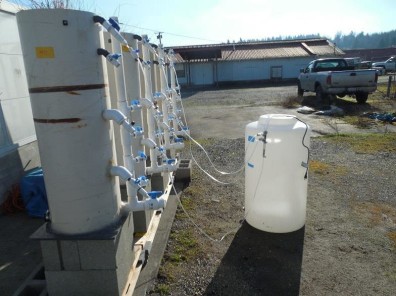
Low impact development (LID) structures (e.g. rain gardens and bioretention swales) constitute a critical link between these dynamic components of the food-energy-water (FEW) system: water to food through LID impacts on fish, energy to water through climate impacts on water flux through LID structures. These structures are widely regarded as a cost-effective, energy-efficient way to reduce flooding and pollution associated with urbanization, and consequently cities across the U.S. have committed to spend billions of dollars on green stormwater infrastructure in coming decades. Yet little is known about how these systems work to retain water and pollutants or how they will respond to climate change. The scale, accessibility, and diversity of engineered LID systems also make them wonderful laboratories in which to test established theories and develop new basic science linking hydrologic and biogeochemical processes. Together with the Moffett Ecohydrology Lab, we are using the world-class stormwater research facilities at the Washington Stormwater Center in Puyallup, WA to improve understanding of how hydrology interacts with biogeochemical processes to control the fate and transport of nutrients in urban stormwater.
Related Publications
- Norton, R., J.A. Harrison, C.K. Keller, and K. B. Moffett (2017) Effects of storm size and frequency on nitrogen retention, denitrification, and N2O production in bioretention swale mesocosms, Biogeochemistry, DOI 10.1007/s10533-017-0365-2.
- Jacobs, A., and J.A. Harrison, (2014) The effects of floating vegetation on denitrification, nitrogen retention, and greenhouse gas production in wetland microcosms, Biogeochemistry, DOI 10.1007/s10533-013-9947-9.
Modeling Nutrient and Organic Carbon Loads and Sources in California’s Central Valley Watersheds: Taking Existing Monitoring Data to the Next Stage
Concentrations of the nutrients nitrate and phosphorous exceed nationa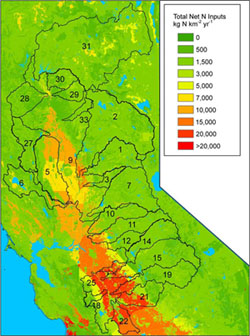 l guidelines in many of the San Joaquin River’s tributaries, contributing to low dissolved-oxygen levels and a rise in the incidence of algal blooms. In the river’s lower reaches, low oxygen levels create a barrier for migrating salmon. High nutrient and dissolved organic carbon concentrations in water destined for public consumption also pose public health issues. The objective of this research is to use existing data and computer models to quantify the fluxes, sources and controls of nitrate, phosphate, and organic carbon throughout the Sacramento and San Joaquin river systems. Some of the specific research questions we are addressing include: 1) What are relative contributions of various land-based sources of dissolved organic carbon and nutrients? 2) How can the ability to predict sources and fluxes of nutrients be improved? 3) How will changes in climate, population growth and increased water demand influence water quality?
l guidelines in many of the San Joaquin River’s tributaries, contributing to low dissolved-oxygen levels and a rise in the incidence of algal blooms. In the river’s lower reaches, low oxygen levels create a barrier for migrating salmon. High nutrient and dissolved organic carbon concentrations in water destined for public consumption also pose public health issues. The objective of this research is to use existing data and computer models to quantify the fluxes, sources and controls of nitrate, phosphate, and organic carbon throughout the Sacramento and San Joaquin river systems. Some of the specific research questions we are addressing include: 1) What are relative contributions of various land-based sources of dissolved organic carbon and nutrients? 2) How can the ability to predict sources and fluxes of nutrients be improved? 3) How will changes in climate, population growth and increased water demand influence water quality?
Related Publications
- Hinshaw, S.E., T. Zhang, J.A. Harrison, and R.A. Dahlgren (2020) Excess N2 and denitrification in riverbed porewaters and groundwaters of the San Joaquin River, California, Water Resources Research. 168:1-12. https://doi.org/10.1016/j.watres.2019.115161.
- Sobota, D.S., J.A. Harrison, and R.A. Dahlgren (2011) Phosphorus in central California rivers: forms of export and relationship with anthropogenic nutrient inputs. Water Resources Research.
(pdf) - Sobota, D. J., J.A. Harrison, and R. A. Dahlgren (2009) Input and export of nitrogen for watersheds in the Central Valley, California: annual and seasonal patterns. Biogeochemistry. DOI 10.1007/s10533-009-9307-y.
(pdf) - Chow, A., R.A. Dahlgren, and J. Harrison. (2007) Watershed sources of disinfection byproduct precursors in the Sacramento and San Joaquin Rivers, California. Environmental Science & Technology, 41(22), 8645-7652.
(pdf) - Harrison, J.A., and P.A. Matson (2003) Patterns and controls of nitrous oxide (N2O) emissions from drainage waters of the Yaqui Valley, Sonora, Mexico. Global Biogeochemical Cycles, 17, (3), 1080, doi:10.1029/2002GB001991, 1-13.
(pdf) - Harrison, J.A. (2003) Nitrogen Dynamics and Greenhouse Gas Production in Yaqui Valley Surface Drainage Waters, Doctoral Thesis, Stanford University
(pdf)
Agriculture and Pollution in the Developing World: Understanding the Link Between Fertilizer Use, Greenhouse Gases, and Coastal Change in Sonora, Mexico
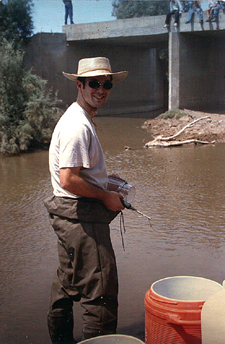
 Roughly half of the nitrogen fertilizer that’s ever been produced on Earth has been used within the last twenty years. This increase in the use of nitrogen fertilizer has led to massive increases in agricultural yield, the amount of grain per unit area. In fact, it has allowed humans to largely avoid the food shortages people have historically predicted to accompany our recent population boom. In this sense, nitrogen fertilizer has been an enormous boon to humans. However, the recent increase in nitrogen use may have serious drawbacks as well. Two of these potential drawbacks are coastal pollution and the increased production of greenhouse gases, leading to global climate change. Our research in the Yaqui Valley investigates the link between agricultural fertilizer use (the largest human source of reactive nitrogen) and its environmental impacts.
Roughly half of the nitrogen fertilizer that’s ever been produced on Earth has been used within the last twenty years. This increase in the use of nitrogen fertilizer has led to massive increases in agricultural yield, the amount of grain per unit area. In fact, it has allowed humans to largely avoid the food shortages people have historically predicted to accompany our recent population boom. In this sense, nitrogen fertilizer has been an enormous boon to humans. However, the recent increase in nitrogen use may have serious drawbacks as well. Two of these potential drawbacks are coastal pollution and the increased production of greenhouse gases, leading to global climate change. Our research in the Yaqui Valley investigates the link between agricultural fertilizer use (the largest human source of reactive nitrogen) and its environmental impacts.
Related Publications
- Ahrens, T., J.A. Harrison, J.M. Beman, P. Jewett, and P.A. Matson (2011) Nitrogen in the Yaqui Valley: sources, transfers, and consequences, Chapter 10 in: P.A. Matson (Ed.) Seeds of Sustainability: Lessons from the Birthplace of the Green Revolution in Agriculture, Island Press, Washington D.C..
- Ahrens T., M.Beman, J. A.Harrison, P.Jewett, P.Matson (2008) Nitrogen transformations and transfers from land to the sea in the Yaqui Valley agricultural region. Water Resources Research, 44, W00A05, doi:10.1029/2007WR006661.
(pdf) - Harrison, J.A., P.A. Matson and S. Fendorf (2005) Effects of a diel oxygen cycle on nitrogen transformations and greenhouse gas emission in a eutrophied, subtropical stream, Aquatic Sciences, doi:10.1007.s00027-005-0776-3, 1-8.
(pdf) - Harrison, J.A., and P.A. Matson (2003) Patterns and controls of nitrous oxide (N2O) emissions from drainage waters of the Yaqui Valley, Sonora, Mexico. Global Biogeochemical Cycles, 17, (3), 1080, doi:10.1029/2002GB001991, 1-13.
(pdf) - Harrison, J.A. (2003) Nitrogen Dynamics and Greenhouse Gas Production in Yaqui Valley Surface Drainage Waters, Doctoral Thesis, Stanford University
(pdf)
